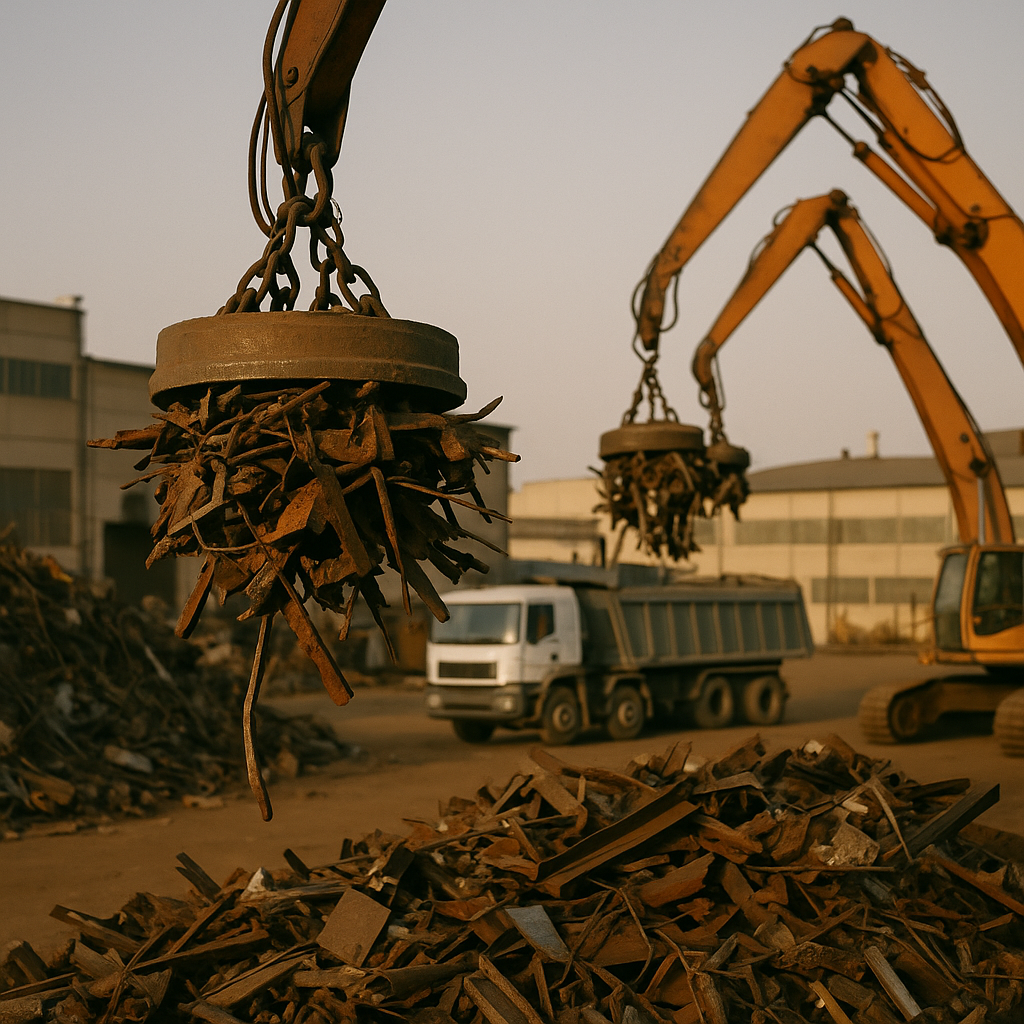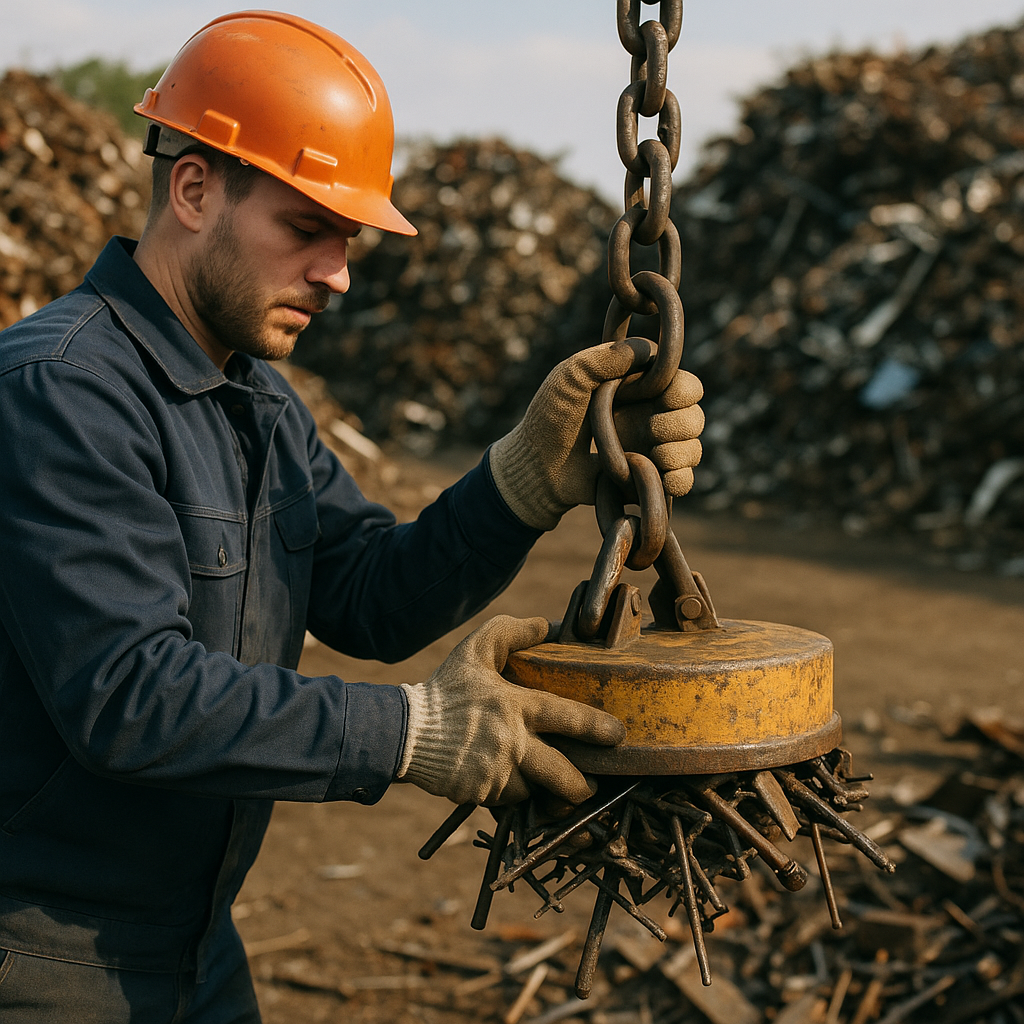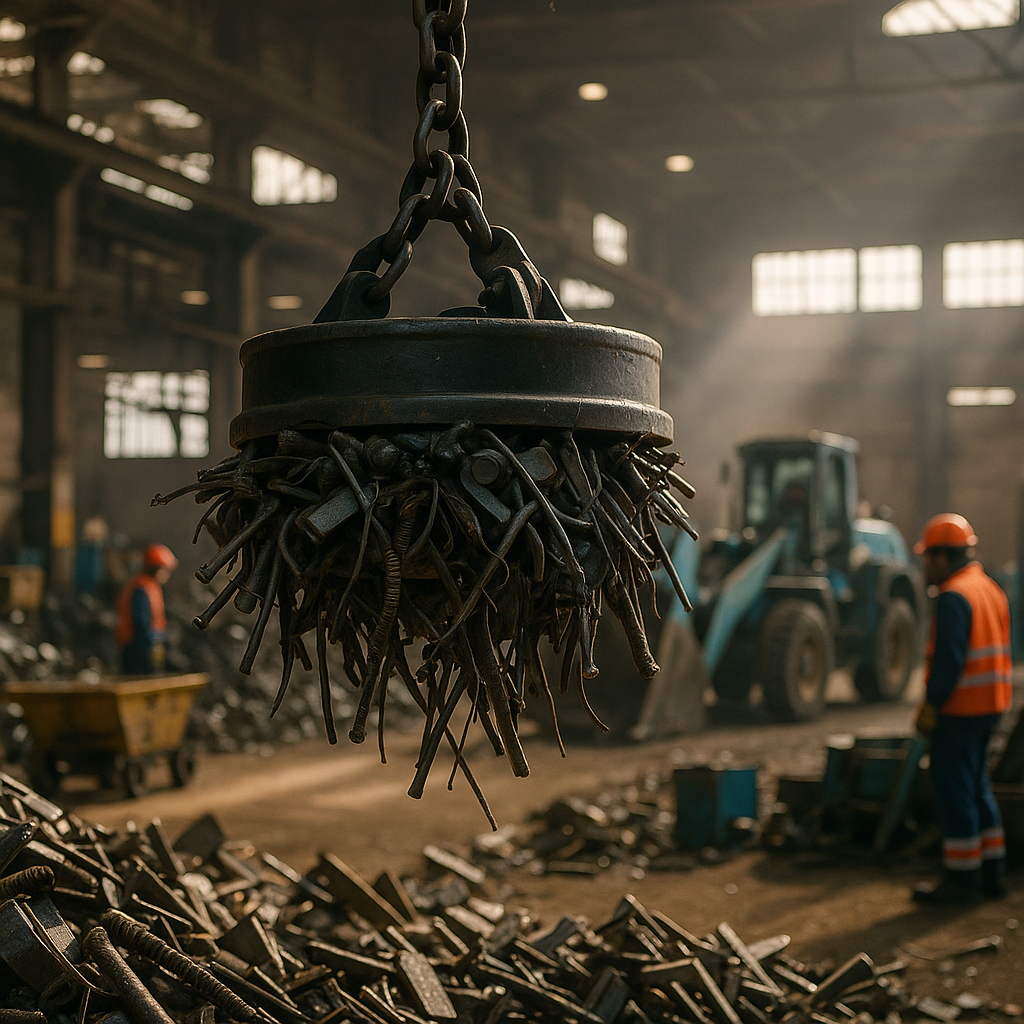5901 Botham Jean Blvd, Dallas, TX 75215
Scrapping Magnets: How Electromagnets Drive Recycling Efficiency and Sustainability
September 2, 2025Scrapping magnets are powerful electromagnets specifically designed to lift, move, and sort ferrous metals in recycling facilities and scrapyards. These industrial workhorses are essential for modern metal recycling operations, enabling the efficient separation of valuable ferrous materials from mixed waste streams.
At their core, scrapping magnets operate on a simple but effective principle. When an electric current flows through copper wire coiled around an iron core, it generates a strong magnetic field that attracts ferrous metals—those containing iron, such as steel, cast iron, and nickel. The strength of this magnetic pull depends on the current intensity and the number of wire turns in the coil.
Unlike permanent magnets, scrapping magnets can be switched on and off as needed. When electricity flows, the magnetic field activates, allowing operators to pick up heavy loads of metal. When the current stops, the magnetism disappears, releasing the materials at the right location. This controllable feature makes electromagnets invaluable in recycling operations where materials must be both gathered and released with precision.
What Industries Rely on Scrapping Magnets?

Scrapping magnets are essential tools in industries where metal recovery and separation are critical. These powerful magnets efficiently extract ferrous materials from mixed waste streams, reducing manual labor while enhancing recovery rates and processing efficiency.
Recycling Facilities and Material Recovery
In recycling facilities, scrapping magnets are central to ferrous metal recovery systems. These facilities use overhead magnets suspended above conveyor belts to separate iron and steel items from mixed waste streams. The self-cleaning models automatically discharge captured metals into collection bins to maintain continuous operation.
Modern material recovery facilities (MRFs) employ specialized magnetic separators designed to handle municipal solid waste efficiently. Some facilities use drum magnets with strong magnetic fields that can extract small ferrous pieces from high-volume waste streams. This technology enables recyclers to process hundreds of tons of material daily while maintaining high recovery rates.
Demolition and Construction
The demolition industry relies on scrapping magnets to recover valuable metals from building debris. When structures are demolished, the waste contains significant amounts of rebar, structural steel, and other ferrous materials. Powerful electromagnets mounted on excavators lift and separate these metals directly from rubble piles.
In construction, scrapping magnets help process and recycle demolition waste on-site, reducing disposal costs and improving sustainability metrics. These magnets extract nails, wire, and other metal fragments from wood and concrete waste, creating cleaner material streams for further processing or reuse in new construction projects.
Foundries and Steel Mills
Foundries and steel mills use scrapping magnets for handling raw materials and managing internal scrap flows. These facilities employ heavy-duty overhead magnets to move large volumes of metal scrap throughout their operations. The magnets transfer materials between processing stages and load furnaces with recovered scrap metal.
The steel industry specifically relies on magnetic separation to ensure high-quality input materials. Before melting, powerful magnets remove unwanted ferrous contaminants from material streams, protecting equipment and maintaining product quality—critical for facilities producing specialized steel grades with strict purity requirements.
| Industry | Application |
|---|---|
| Recycling Facilities | Used in overhead magnets to pull iron and steel from waste streams, enhancing recovery rates and processing efficiency. |
| Demolition and Construction | Employed to recover metals from building debris and recycle demolition waste on-site for improved sustainability. |
| Foundries and Steel Mills | Used for handling raw materials, managing scrap flows, and ensuring high-quality input materials through magnetic separation. |
| Automotive Recycling | Applied in the processing of end-of-life vehicles, maximizing metal recovery from shredded waste. |
Automotive Recycling
The automotive recycling sector is one of the largest users of scrapping magnets. When processing end-of-life vehicles, facilities first remove valuable components before shredding the remaining materials. Powerful magnetic separators then extract ferrous metals from this shredded waste, recovering steel, iron, and other magnetic components.
Modern auto recyclers use sophisticated magnetic systems to maximize metal recovery. Deep-field permanent magnets or electromagnets separate ferrous materials, while eddy current separators recover non-ferrous metals like aluminum and copper. This comprehensive approach enables recyclers to recover up to 95% of a vehicle’s metal content, significantly reducing landfill waste while recapturing valuable resources.
Recycling permanent magnets from electric vehicles is becoming a focus in this sector. As EV adoption increases, recovering rare earth elements from motor magnets becomes economically viable. Specialized processes allow the recovery of neodymium, dysprosium, and other critical materials from these high-value components, creating a circular supply chain for these strategic resources.
Key Benefits of Using Scrapping Magnets

Scrapping magnets have significantly enhanced the metal recycling and waste management industries by offering substantial operational benefits. These powerful tools change how businesses handle ferrous materials, improving efficiencies that directly impact the bottom line. Let’s delve into the primary benefits these specialized magnets provide to recycling operations, demolition projects, and scrap processing facilities.
Operational Efficiency and Throughput
One of the greatest advantages of scrapping magnets is their ability to greatly increase operational efficiency. These powerful electromagnets can quickly lift, sort, and relocate large quantities of ferrous metal. A single magnet can handle volumes that would require multiple workers using traditional methods.
The streamlined material flow not only speeds up operations but also creates a continuous processing environment where ferrous metals move swiftly through your facility. Scrapyards integrating magnetic technology report processing speed increases of 30–50% compared to manual sorting methods.
This efficiency directly translates into higher daily throughput capacities. Whether handling demolition waste, processing automotive scrap, or managing a recycling facility, the ability to process more material in less time offers immediate operational advantages.
Superior Material Sorting and Recovery
Scrapping magnets excel in precise material separation. They effectively isolate ferrous metals from mixed waste streams with remarkable accuracy, ensuring that valuable metals don’t end up in landfills.
This technology enables the recovery of ferrous materials from complex waste streams, including construction debris, electronic waste, and industrial byproducts. Modern scrapping magnets can detect and extract even small ferrous particles, maximizing recovery rates.
The sorting precision leads to higher-grade recovered materials. When ferrous metals are cleanly separated from other waste, they command better market prices. The purity of magnetically separated scrap makes it ideal for remelting operations, creating a premium product meeting stringent industry specifications.
Labor Reduction and Safety Enhancements
Scrapping magnets significantly reduce labor needs. Tasks once requiring teams of workers can now be completed by a single operator controlling the magnet, delivering substantial cost savings over time.
Beyond cost savings, scrapping magnets enhance workplace safety by eliminating the need for manual handling of heavy, potentially sharp metal objects. Workers no longer need to sort through debris manually, reducing injuries such as cuts and back strains.
Safety improvements also reduce exposure to hazardous materials. In demolition and industrial scrap processing, workers might encounter contaminated materials. Magnetic separation allows for remote handling, minimizing contact with potentially dangerous substances.
Space Utilization and Facility Management
Scrapping magnets enable more efficient use of facility space. Their lifting power allows for vertical stacking of materials, maximizing storage capacity within limited footprints. This vertical utilization creates more working room in processing areas.
The technology also allows better organization of material inventories. Different grades and types of ferrous scrap can be precisely sorted and stored separately, improving inventory management and creating more orderly facilities.
This optimized space utilization is particularly valuable in urban recycling operations where real estate is at a premium. Processing more material in less space directly impacts profitability.
Environmental and Economic Benefits
Scrapping magnets contribute significantly to sustainability goals by enabling more complete recovery of metal resources, reducing the need for virgin material extraction. This conserves natural resources and provides a substantial environmental benefit.
The economic benefits are also compelling. Businesses using scrapping magnets can create new revenue streams by recovering valuable metals that would otherwise be lost, turning what was once considered waste into valuable commodities.
The high-volume, automated ferrous recovery process produces clean, high-grade scrap ideal for remelting. These premium materials fetch better market prices than mixed or contaminated scrap, improving profit margins for recycling operations.
For demolition projects, scrapping magnets create additional value by efficiently separating valuable metals from debris. This metal recovery can offset demolition costs and generate additional revenue from projects.
Overall operational efficiencies—reduced labor, faster processing, better space utilization, and higher quality output—combine to create a compelling return on investment. Most facilities find their investment in scrapping magnets pays for itself through operational savings and increased material recovery.
How Are Scrapping Magnets Maintained and Repaired?

Proper maintenance of scrapping magnets is vital for safety, operational efficiency, and maximizing return on investment. The strong magnetic fields these machines generate require careful handling and regular upkeep to prevent failures during critical operations.
Daily Inspection Protocols
Each operational day should start with thorough visual inspections of the magnet system. Inspect the exterior casing for any physical damage that might compromise internal components. Cracks or dents can signal structural weaknesses.
Check lifting chains and attachment points for signs of wear, stretching, or corrosion. These components bear the entire load weight and pose a significant safety risk if compromised. Replace any chains showing more than 10% wear promptly.
Electrical connections require careful examination during daily checks. Look for frayed wires, loose connections, or signs of overheating at terminal points. Even minor electrical issues can lead to system failure or unsafe operating conditions.
Scheduled Preventive Maintenance
Beyond daily inspections, establish a regular maintenance schedule that includes testing the magnet’s coil insulation. This test measures electrical resistance to identify potential shorts or weakening insulation before failure occurs.
Clean the magnet surface regularly to remove metal debris that could impact performance. Small metal particles can accumulate in critical areas and interfere with the magnetic field generation.
Document all maintenance activities in a dedicated log. This record is invaluable for tracking performance patterns and anticipating when components might need replacement based on historical data.
Professional Repair Services
When repairs are necessary, specialized services provide comprehensive diagnostics beyond standard maintenance. Technicians use advanced equipment to identify issues within the magnet’s internal components.
Professional repair typically includes disassembly, cleaning of internal components, replacing damaged parts, and reassembly per manufacturer specifications. This approach addresses both immediate and potential developing issues.
Many repair services offer warranties, providing protection against recurring problems. This coverage can significantly reduce long-term maintenance costs and ensure operational reliability.
Investing in professional repairs often results in substantial returns through extended equipment life and reduced downtime. A well-repaired magnet should perform near-original specifications, maintaining lifting capacity and operational efficiency.
Safety Considerations During Maintenance
Always disconnect power sources completely before performing maintenance on electromagnetic scrapping magnets. Verify power disconnection with appropriate testing equipment before starting work.
Use proper personal protective equipment, including insulated gloves and safety eyewear, when working with magnetic equipment. Metal tools can become projectiles if brought too close to powered magnets.
Keep sensitive electronic devices away from the maintenance area. Strong magnetic fields can damage computers, phones, and medical devices like pacemakers.
Never attempt to lift or move a magnet while standing underneath it. Position yourself away from the load path during testing or maintenance procedures to avoid crushing injuries in case of attachment point failure.
What is the Future of Scrapping Magnets and Metal Recycling?

The future of scrapping magnets is being transformed by technological innovation, particularly in the recovery of rare earth elements vital to our modern world. These powerful magnets, found in devices from smartphones to wind turbines, contain valuable materials becoming increasingly critical as global demand rises. Industry experts predict that the need for rare earth elements could increase by up to seven times current levels by 2040, making recycling not just environmentally friendly but also economically essential.
Advanced recycling processes are emerging to address the unique challenges of magnet recycling. One promising technology involves hydrogen-based recycling, which turns magnets into demagnetized powder for easier collection and processing. This method is valuable as it simplifies handling these powerful magnets while preserving the integrity of the rare earth materials.
Innovations in Rare Earth Recovery
Flash joule heating represents another breakthrough in magnet recycling technology. This method uses rapid electrical bursts to efficiently separate rare earth metals from electronic waste. The results are impressive, with metal purities exceeding 95% and recovery yields of more than 85%. Such high-efficiency processes make recycling increasingly competitive with primary mining.
Artificial intelligence is also revolutionizing the sorting phase of recycling. AI-driven systems can now identify and categorize components with exceptional accuracy and speed, boosting overall recycling efficiency while reducing contamination. These smart systems are particularly valuable when processing complex electronic waste containing small amounts of rare earth magnets.
Perhaps most promising for environmental concerns are the bio-based extraction methods under development. Scientists are utilizing microorganisms to extract rare earth elements from electronic waste, providing a more environmentally friendly alternative to traditional chemical processes. This approach significantly reduces the environmental footprint of recycling operations.
Economic and Supply Chain Benefits
The economic implications of advanced magnet recycling extend far beyond simple resource recovery. With China currently producing over 80% of refined rare earth elements, recycling offers countries a pathway to greater supply chain resilience. The European Union has already invested €90 million to bolster its rare earth recycling capacity, aiming to reduce import reliance by up to 30% over the next decade.
Recycling can also help stabilize prices in a notoriously volatile market. Studies show recycled neodymium has experienced 20% less price volatility than newly mined sources over a five-year period. This stability benefits manufacturers across multiple industries, from electric vehicles to renewable energy technologies, enabling more predictable costs and planning.
Job creation represents another significant economic benefit. The recycling industry generates employment opportunities across various skill levels, from collection and sorting to high-tech processing roles. As facilities expand, they create demand for transportation services, equipment manufacturing, and technology development, creating a positive economic ripple effect.
| Technology | Process | Advantages | Challenges |
|---|---|---|---|
| Hydrogen Processing of Magnet Scrap (HPMS) | Uses hydrogen gas to break down magnets into powder | Energy-efficient, low emission, works without high-temperature smelting | Securing consistent feedstock supplies |
| Pyrometallurgical Recycling | Involves heating and smelting to recover REEs | Existing method with established use | High energy use, impurities in the final product |
| Hydrometallurgical Recycling | Uses specialized liquids for REE extraction | Commonly used with various solvent methods | Environmental and safety concerns |
| Ionic Liquid Technology | Liquid-liquid extraction using ionic liquids | High purity REE oxides produced | Process still in R&D or pilot stages |
Challenges to Overcome
Despite promising developments, several challenges remain for rare earth magnet recycling. Securing consistent feedstock supplies is difficult until more electric vehicles and wind turbines reach the end of their lifecycle. Companies are addressing this by initially focusing on readily available sources like hard disk drives from data centers before expanding to additional waste streams.
The complex extraction process presents another hurdle. Magnets are often deeply embedded within devices, making their removal labor-intensive and costly. Additionally, ensuring the purity of recovered materials remains challenging, particularly when processing post-consumer goods, where contamination is common.
Collection infrastructure for end-of-life products containing rare earth magnets is also underdeveloped. Without established systems to gather these materials, creating a stable supply chain for recycled magnets is difficult, especially for consumer electronics that often end up in landfills instead of recycling facilities.
Despite these challenges, the future of magnet recycling looks promising. As technology advances and awareness grows, recycling rates and efficiencies are expected to improve significantly. The combination of environmental benefits, economic opportunities, and supply chain security makes rare earth magnet recycling an increasingly attractive proposition for businesses, governments, and environmentally conscious consumers alike.
Conclusion: The Critical Role of Scrapping Magnets in Modern Recycling

Scrapping magnets are vital tools in modern recycling. They efficiently separate ferrous metals from mixed waste streams, enhancing material recovery’s effectiveness and economy. The use of permanent magnets, electromagnetic systems, and advanced separators has revolutionized recycling facilities worldwide. These technologies reduce manual labor and significantly improve sorting accuracy and processing volumes.
The environmental benefits of magnetic separation are substantial. By recovering valuable metals that might otherwise end up in landfills, scrapping magnets help conserve natural resources and reduce the impact of mining. This is especially important for rare earth metals used in electronics and green technologies. As global sustainability standards become stricter, the role of magnetic separation will grow in creating circular economy solutions. For assistance with implementing effective magnetic separation in your recycling operations, contact Okon Recycling at 214-717-4083.
